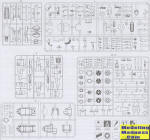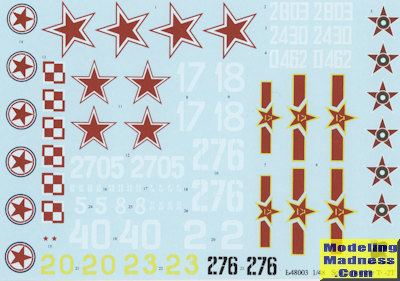
Xuntong Model 1/48 Tu-2T
| KIT #: | B 48003 |
| PRICE: | $48.95 SRP |
| DECALS: | Six options |
| REVIEWER: | Scott Van Aken |
| NOTES: |

| HISTORY |
The Tupolev Tu-2 (development names ANT-58 and 103; NATO reporting name Bat) was a twin-engine Soviet high-speed daylight and front-line (SDB and FB) bomber aircraft of World War II vintage. The Tu-2 was tailored to meet a requirement for a high-speed bomber or dive-bomber, with a large internal bomb load, and speed similar to that of a single-seat fighter. Designed to challenge the German Junkers Ju 88, the Tu-2 proved comparable, and was produced in torpedo, interceptor and reconnaissance versions. The Tu-2 was one of the outstanding combat aircraft of World War II and it played a key role in the Red Army's final offensives. The Tu-2T was the torpedo-bomber variant, was tested between February and March 1945, and issued to Soviet Naval Aviation units in the last days of the war in Europe.
| THE KIT |
 This
kit has gotten some good press regarding its accuracy and how nicely
it fits. This is always nice to hear before starting on a project
like this. I was impressed to see that the first order of business
in the kit instructions were to open the various holes and remove
some tabs in order to model this variant. I can tell you from
experience that I've missed/forgotten things like this when the
instructions have you do this later in the build. Since this is a
torpedo plane, you are to remove the hinge tabs from the bomb bay
and you are also to remove the tabs that allow the engine cowlings
to be open. This is a bit odd as the engines are quite detailed.
This
kit has gotten some good press regarding its accuracy and how nicely
it fits. This is always nice to hear before starting on a project
like this. I was impressed to see that the first order of business
in the kit instructions were to open the various holes and remove
some tabs in order to model this variant. I can tell you from
experience that I've missed/forgotten things like this when the
instructions have you do this later in the build. Since this is a
torpedo plane, you are to remove the hinge tabs from the bomb bay
and you are also to remove the tabs that allow the engine cowlings
to be open. This is a bit odd as the engines are quite detailed.  The
final of many construction steps is the installation of torpedo
mounts, torpedoes, props and other small bits.
The
final of many construction steps is the installation of torpedo
mounts, torpedoes, props and other small bits. | CONCLUSIONS |
| REFERENCES |
https://en.wikipedia.org/wiki/Tupolev_Tu-2
May 2016
Thanks to me for picking this one up.
If you would like your product reviewed fairly and fairly quickly, please contact the editor or see other details in the Note to Contributors.
Back to the Previews Index Page